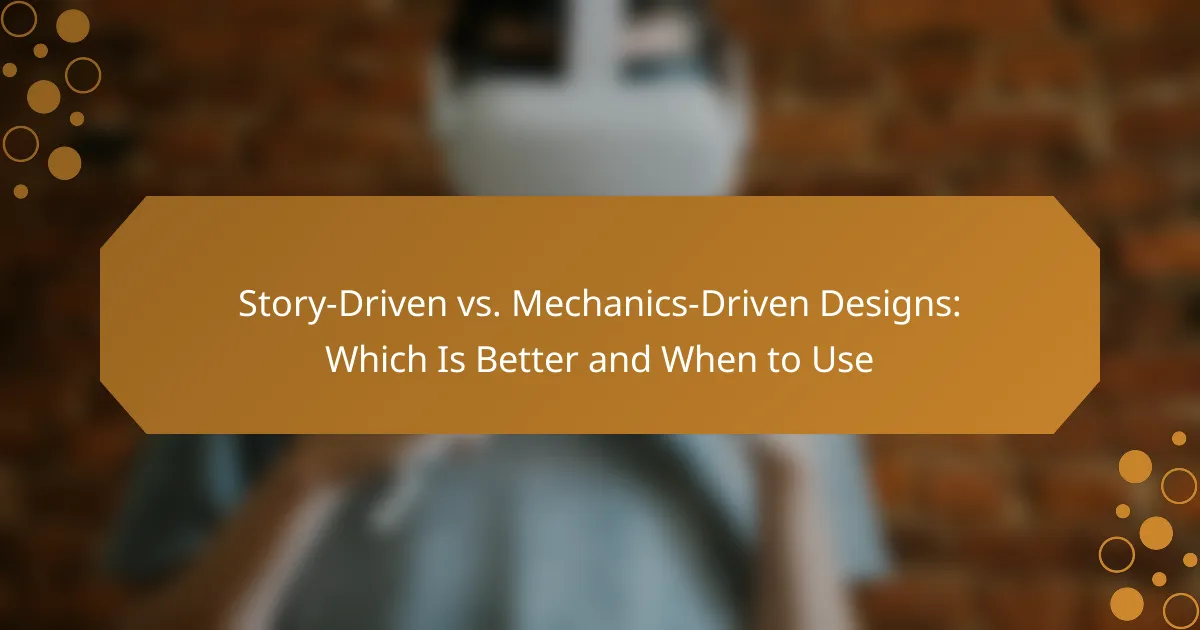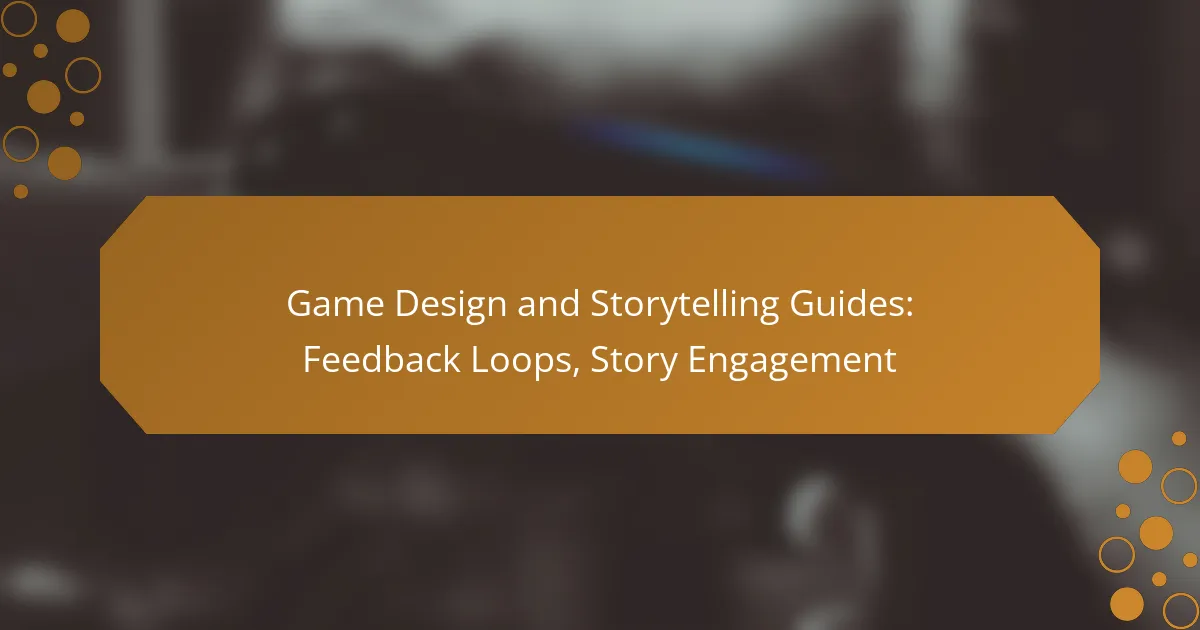In the realm of design, the choice between story-driven and mechanics-driven approaches can significantly impact user engagement and experience. Story-driven designs create emotional connections through narrative, while mechanics-driven designs prioritize clarity and efficiency through structured systems. Understanding when to employ each method is crucial for maximizing user interaction and achieving desired outcomes.

What are the advantages of story-driven designs?
Story-driven designs offer a unique way to engage users by weaving narratives into the user experience. This approach can lead to deeper connections and a more memorable interaction with the product or service.
Enhanced emotional engagement
Story-driven designs tap into human emotions, creating a more immersive experience. By presenting relatable characters and situations, users can see themselves in the narrative, which fosters empathy and connection.
For example, a mobile game that features a compelling storyline can keep players invested in the characters’ journeys, leading to a more enjoyable experience. This emotional investment often translates to longer interaction times and increased satisfaction.
Improved user retention
When users feel emotionally connected to a story, they are more likely to return. Story-driven designs can create a sense of anticipation, encouraging users to come back for updates or new chapters in the narrative.
Consider a subscription service that releases content in episodic formats. Users are more inclined to renew their subscriptions if they are eager to see how the story unfolds, resulting in higher retention rates compared to purely mechanics-driven platforms.
Stronger brand identity
A well-crafted story can significantly enhance a brand’s identity, making it more recognizable and relatable. By consistently integrating narrative elements into marketing and product design, brands can communicate their values and mission effectively.
For instance, brands like Nike use storytelling in their campaigns to convey messages of perseverance and achievement, which resonate with their audience. This approach not only strengthens brand loyalty but also differentiates them in a competitive market.
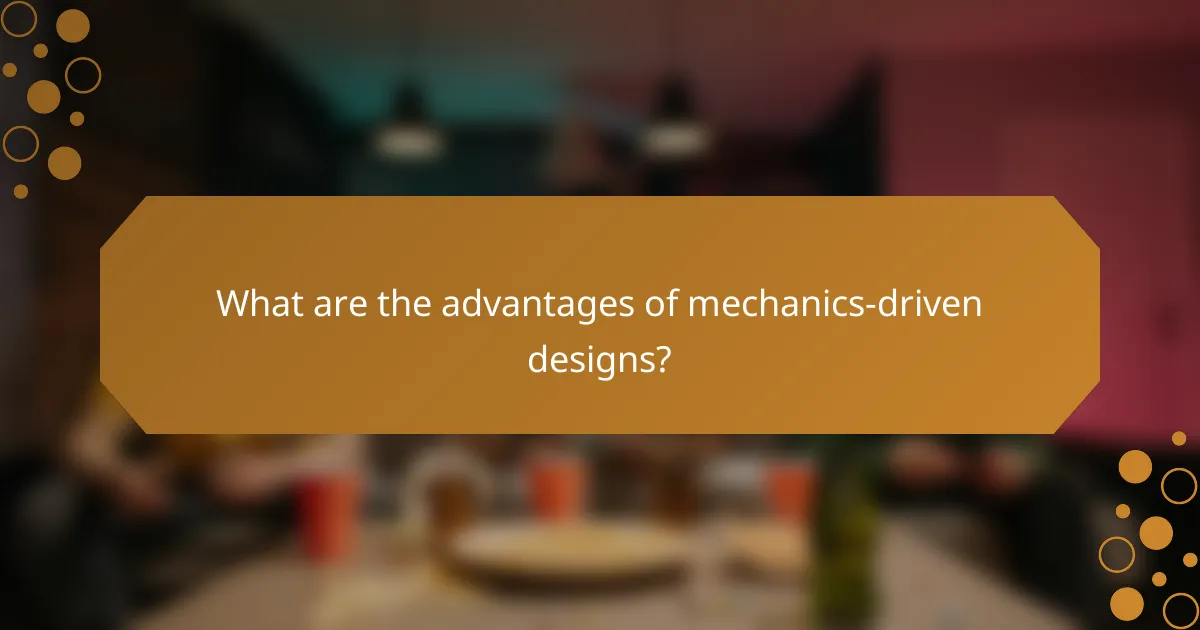
What are the advantages of mechanics-driven designs?
Mechanics-driven designs focus on the underlying systems and rules that govern user interactions, providing clarity and efficiency. These designs often lead to better user engagement and performance by emphasizing clear objectives and streamlined processes.
Clearer user objectives
Mechanics-driven designs establish explicit goals for users, making it easier for them to understand what is expected. This clarity helps reduce confusion and enhances motivation, as users can easily identify their progress and achievements.
For instance, in a game, a clear set of mechanics such as levels, points, and rewards can guide players toward specific objectives, ensuring they know what actions to take to succeed.
Streamlined user experience
By focusing on mechanics, designers can create a more efficient user experience, minimizing unnecessary steps and distractions. This streamlined approach allows users to engage with the content or system more effectively, leading to quicker task completion.
For example, an app that uses straightforward mechanics for navigation and task execution can reduce the time users spend figuring out how to use it, enhancing overall satisfaction.
Higher performance metrics
Mechanics-driven designs often yield better performance metrics, such as increased user retention and higher conversion rates. By providing clear pathways and objectives, users are more likely to engage consistently and achieve desired outcomes.
In e-commerce, a mechanics-driven approach that simplifies the purchasing process can lead to higher sales conversions, as users face fewer obstacles when making decisions. Tracking these metrics can help refine the design further for optimal results.
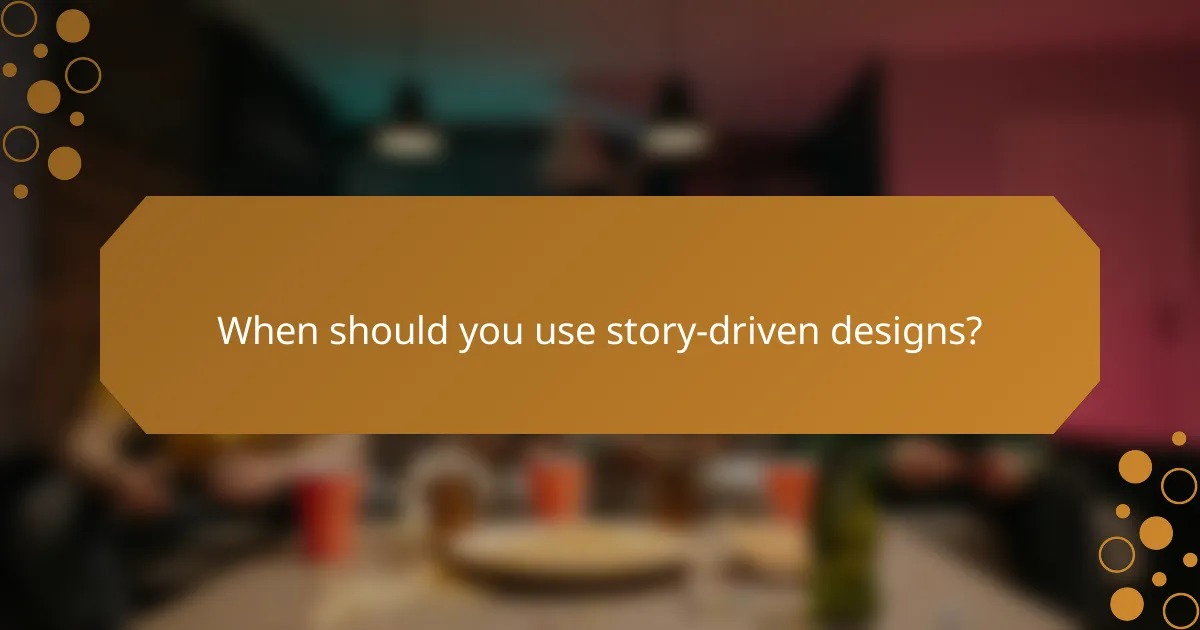
When should you use story-driven designs?
Story-driven designs are best utilized when the goal is to engage users emotionally and create a memorable experience. These designs work effectively in contexts where narratives can enhance understanding and connection, such as in creative projects or brand storytelling.
Creative projects and narratives
In creative projects, story-driven designs help convey complex ideas through relatable narratives. For instance, a video game that immerses players in a rich storyline can enhance engagement and retention. Consider using character arcs and plot twists to keep the audience invested.
When developing narratives, focus on creating a clear beginning, middle, and end. This structure helps guide users through the experience, making it easier for them to connect with the content. Avoid overly complicated plots that may confuse rather than engage.
Brand storytelling initiatives
Brand storytelling initiatives leverage narratives to build emotional connections with customers. By sharing authentic stories about the brand’s values, mission, or customer experiences, businesses can foster loyalty and trust. For example, a company might highlight its origins or showcase customer success stories to resonate with its audience.
To implement effective brand storytelling, ensure that the narrative aligns with the brand’s identity and values. Use visuals and language that reflect the brand’s tone, and consider integrating user-generated content to enhance authenticity. Avoid generic stories that lack a unique perspective, as they may fail to capture attention.
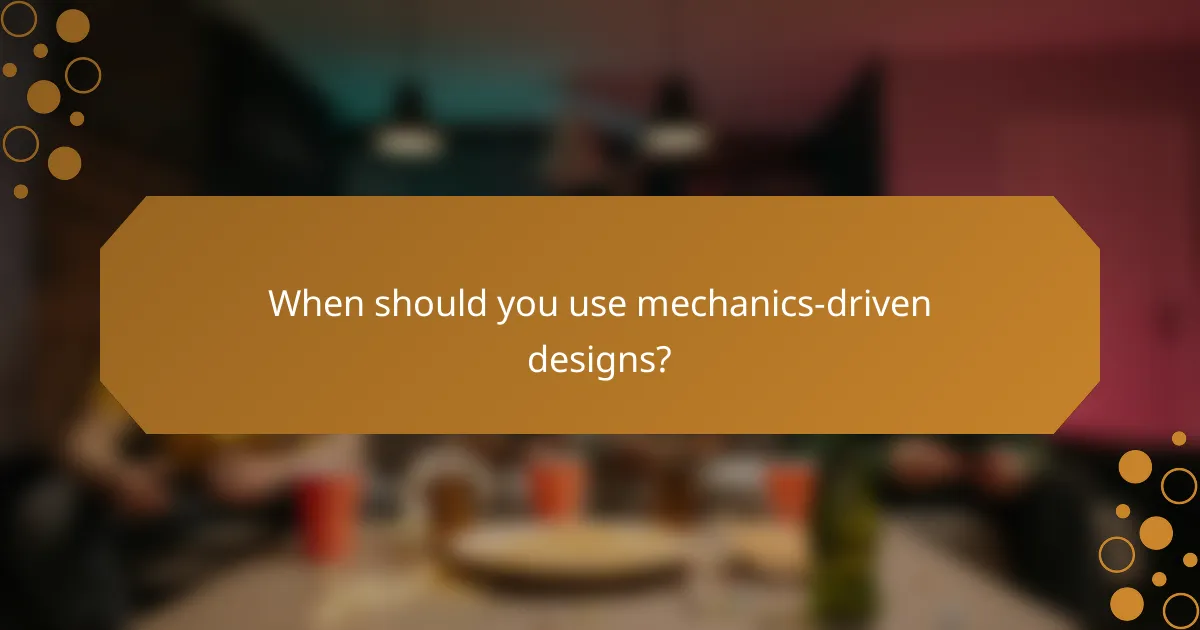
When should you use mechanics-driven designs?
Mechanics-driven designs are best utilized when functionality and user interaction are paramount. These designs prioritize the underlying systems and processes that drive user engagement, making them ideal for applications where performance and efficiency are critical.
Data-driven applications
Data-driven applications rely heavily on mechanics to process and present information efficiently. In these cases, the design should focus on optimizing data retrieval, storage, and visualization. For instance, applications like dashboards or analytics tools benefit from mechanics-driven designs that allow users to quickly access and manipulate large datasets.
When developing a data-driven application, consider using robust back-end systems and responsive front-end frameworks. This ensures that data flows seamlessly, providing users with real-time insights without lag. A common pitfall is overloading the interface with unnecessary features, which can detract from the core functionality.
Functional product interfaces
Functional product interfaces prioritize user tasks and workflows, making mechanics-driven designs essential. These interfaces should facilitate smooth interactions, ensuring that users can complete their objectives with minimal friction. For example, e-commerce websites often utilize mechanics-driven designs to streamline the purchasing process, from product selection to checkout.
To create an effective functional interface, focus on intuitive navigation, clear calls to action, and efficient loading times. Avoid cluttering the interface with excessive options that may confuse users. Instead, aim for a clean design that highlights essential functions, enhancing the overall user experience.
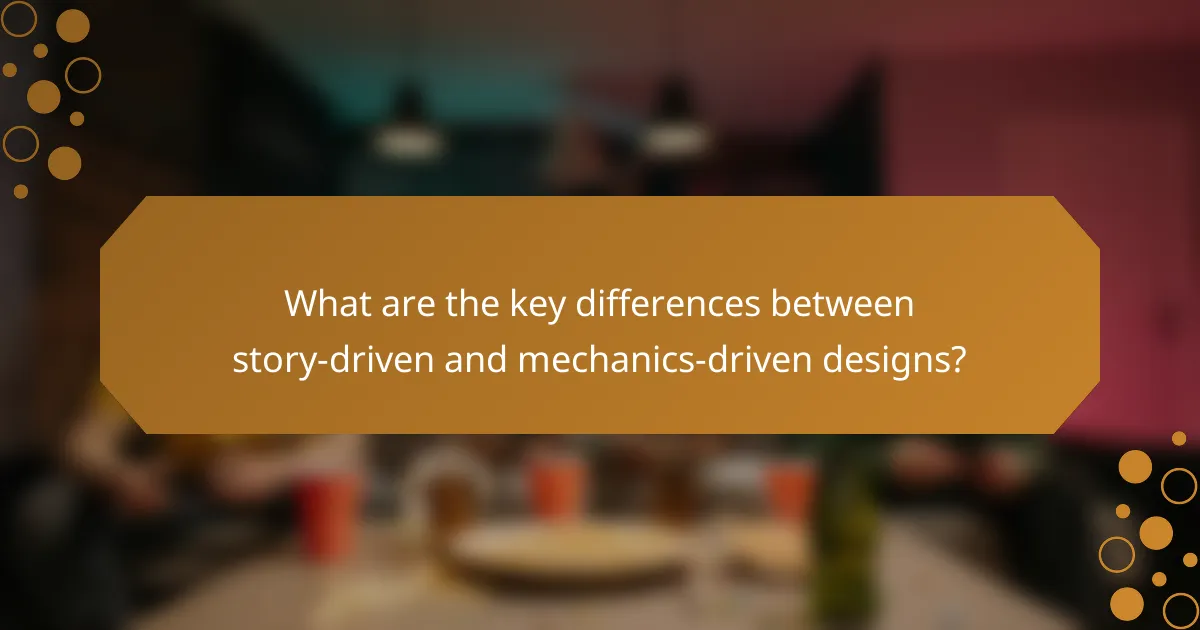
What are the key differences between story-driven and mechanics-driven designs?
Story-driven designs prioritize narrative and character development, while mechanics-driven designs focus on gameplay systems and rules. Understanding these differences helps in choosing the right approach for the intended audience and project goals.
Focus on narrative vs. functionality
Story-driven designs emphasize a compelling narrative that engages players through character arcs and plot twists. This approach often leads to immersive experiences where players feel emotionally connected to the story.
In contrast, mechanics-driven designs prioritize gameplay functionality, ensuring that the rules and systems are engaging and balanced. This can result in a more strategic experience where players focus on optimizing their actions within the game’s framework.
Emotional vs. logical appeal
Story-driven designs appeal to players’ emotions, creating a sense of investment in the characters and their journeys. This emotional connection can enhance player satisfaction and encourage deeper engagement with the game.
Mechanics-driven designs appeal to players’ logic and problem-solving skills, often rewarding strategic thinking and skillful execution. This approach can attract players who enjoy challenges and competition, as they seek to master the game’s systems.
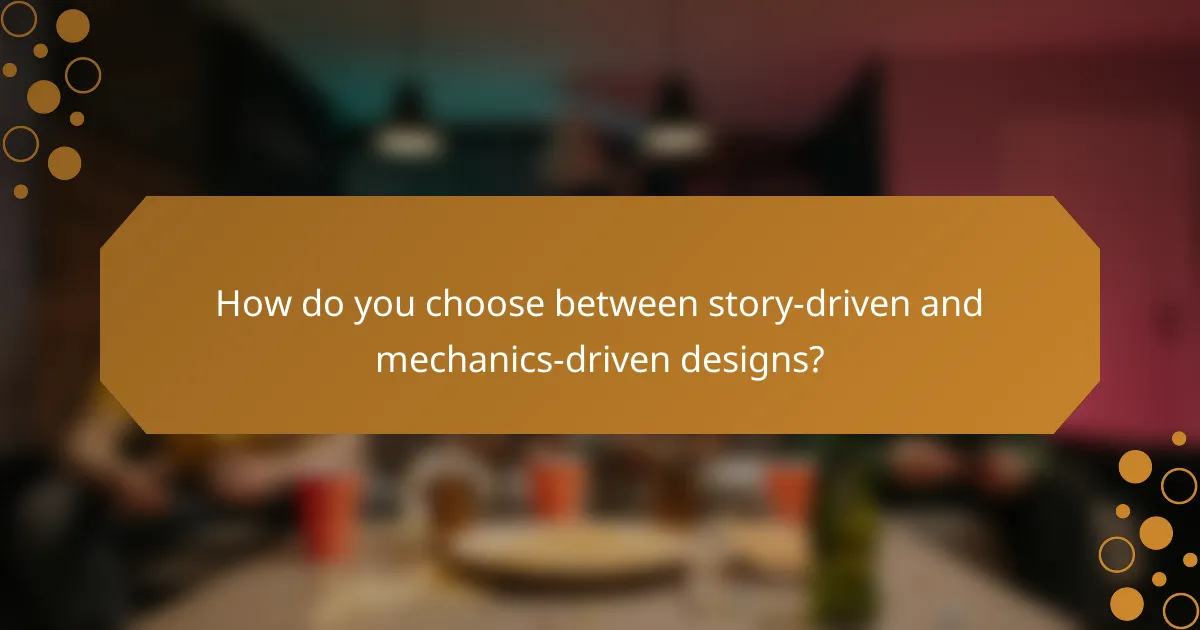
How do you choose between story-driven and mechanics-driven designs?
Choosing between story-driven and mechanics-driven designs depends on your project’s goals and target audience. Story-driven designs focus on narrative and emotional engagement, while mechanics-driven designs prioritize gameplay mechanics and user interaction.
Assess project goals
Begin by clearly defining the objectives of your project. If the primary aim is to evoke emotions or convey a message, a story-driven design may be more effective. Conversely, if the goal is to create an engaging gameplay experience, mechanics-driven design should take precedence.
Consider the target audience as well. For instance, narrative-heavy games often appeal to players who enjoy immersive experiences, while mechanics-focused games attract those who prioritize skill and strategy. Aligning your design approach with audience preferences can enhance engagement and satisfaction.
